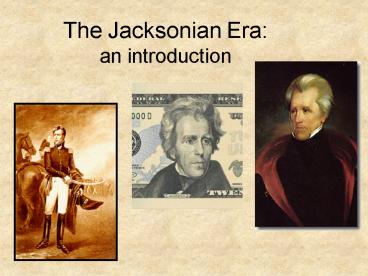The Jacksonian Era: an introduction - PowerPoint PPT Presentation
1 / 8
Title:
The Jacksonian Era: an introduction
Description:
Jeffersonian Democracy believed that capable, well educated leaders should ... Led by Andrew Jackson and (later) Martin Van Buren. ... – PowerPoint PPT presentation
Number of Views:706
Avg rating:3.0/5.0
Title: The Jacksonian Era: an introduction
1
The Jacksonian Era an introduction
2
Jeffersonian v. Jacksonian Democracy
- Jeffersonian Democracy believed that capable,
well educated leaders should govern in the
peoples interest. - Jacksonian Democracy believed that the PEOPLE
should manage government affairs - Jeffersonian Democracy reflected a chiefly
agricultural society - Jacksonian Democracy reflected an agricultural
AND rising industrial society - Jeffersonian Democracy limited democracy to
chiefly its political aspects - Jacksonian Democracy expanded democracy beyond
political aspects to include social and economic
factors - Jeffersonian democracy the people should be
governed as little as possible. -- Govt for the
people - Jacksonian democracy government should be done
directly by the people. -- This idea would
lead to Jacksons spoils system - Jeffersonian democracy was created by Jefferson
Jacksonian democracy pre-dated Jacksons
presidency produced him.
3
Voting Requirements in the Early 19th c.
4
Voter Turnout 1820 - 1860
5
Growth of Democracy in the Jacksonian Era
- By 1828 most states had
- Removed property and religious qualifications for
office holding and voting. Now most white males
could vote. - Increased the number of elected rather than
appointed state and local officials - Given the people a greater check upon elected
officials by shortening their terms of office - Spoils system in local and state politics
- Democracy gains in Presidential Elections
- Starting in 1832, presidential candidates of each
party were no longer named in a caucus of a few
party leaders, now they were selected by a larger
number of active party members at a nominating
convention. - By 1832 the presidential electors of all but one
state were chosen directly by the voters, instead
of by state legislatures. - Rise of Third Parties 1832 Anti-Masonic Party
- Popular campaigning in presidential state
political races (baby kissing, parades,
rallies, floats, etc.)
6
Two-party system returned in the 1832 election
- In response to Jacksons 1st term
- Dem-Reps ? Natl. Reps. (1828) ? Whigs (1832) ?
- v.
- Democrats (1828)
7
Revival of the two party system
- Jackson forms the DEMOCRATS
- Led by Andrew Jackson and (later) Martin Van
Buren. - Consisted of small farmers, newly emerging
businessmen, and city workers (working class). - Opposed an all-powerful federal government, urged
greater democracy, and conformed to Jeffersonian
ideals. - Opposition formed the NATIONAL
REPUBLICANS--Later called the WHIGS - led by Clay, Adams, and later by Daniel Webster.
- Played to the masses, but derived their strength
chiefly from well established classes - bankers,
merchants, manufacturers, and large landowners. - Stood for a strong federal government, a national
bank, protective tariffs, and favored the
interests of business - resembled Hamiltons
Federalist Party.
8
Essential Question
KingAndrew?
OR
Champion of the Common Man?































